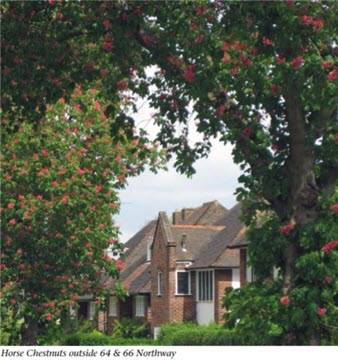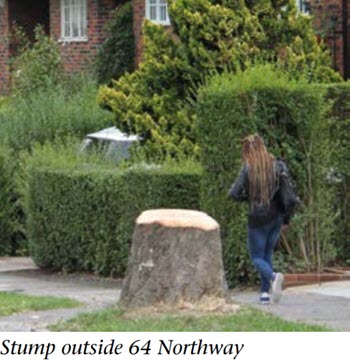LB Barnet Trees Policy & Planned Work


The HGSRA has enjoyed a close working liaison with Barnet Council’s Tree Officers for more than 20 years, focussing primarily on restoring the Suburb’s original planting design, which included street tree species. A presentation at Fellowship House by Andy Tipping, the LB Barnet Trees & Woodlands Manager, last year gave an overview of the new Barnet Tree Policy published in 2017.
This article summarises some sections of the Policy dealing with common queries from residents. The full policy can be seen on the Council’s website at: www. barnet.gov.uk/citizen-home/ parks-sport-and-leisure/trees/ tree-policy.html. Figures at the end of paragraphs refer to paragraph numbers in the Policy.
LB BARNET PLANNED TREE WORK 2019
LB Barnet planned tree work 2019 - roads (pdf)
LB Barnet planned tree work 2019 - open spaces (pdf)
LB BARNET TREE POLICY
LB Barnet has a Tree Policy relating to trees on land owned by the Council, including street trees, parks and open spaces. A small team of qualified and experienced arboriculturists is employed directly by the Council, and all work is carried out by contractors employed on fixed terms. (0.1, 0.2)
The policy outlines how the Council manages a healthy, diverse and extensive tree stock, and why certain works are carried out on certain trees. (0.3)
Relevant issues considered by the Tree officers are aesthetics, risk management, resident concerns, ecosystem services delivery (Urban Heat Island management, shade to reduce temperatures, biodiversity, flood alleviation) national and city-wide targets. (1.5, 1.6)
Tree maintenance and subsidence
Trees which may present a risk of building damage from subsidence are assessed for this, and if found appropriate, managed according to guidance published by the London Tree Officers Association (LTOA) referred to in all recent court cases by the judiciary. This recommends a system of cyclical maintenance, selective removal where justified following a claim and where evidence is conclusive, and occasionally root barrier installation below ground. (1.22, 1.23, 1.25)
Planned maintenance is carried out as a three year cycle following tree surveys that identify any necessary works. This work concentrates on maintaining trees in their immediate environment with due regard to encroachment, shape, future growth of tree, and subsidence risk management. (2.1) Works outside the cyclical pruning cycle may be carried out if a tree is found to be in an unreasonable condition in the context of neighbouring properties, or a tree is missed from the cyclical maintenance program. (2.10)
Works in response to a query are carried out monthly where the Tree Officer deems work to be necessary. (2.2)
Urgent works are usually prompted by resident contact and can be caused by adverse weather, vehicle damage or tree failure. They are usually dealt with within seven days or if found to be an emergency will be dealt with immediately or within 24 hours depending on condition. (2.3)
There is an out-of-hours service on 020 8359 2000.
Removal of healthy trees is undertaken only in exceptional circumstances only, normally when remedial pruning cannot be undertaken or an engineered solution cannot be implemented. (2.4)
Where street trees are growing at an angle, action required in each case will be assessed on its merits.(2.35)
Where tree removal has been requested by residents and this removal is assessed as unjustified by council officers, if resident is not satisfied, there is a review and complaints procedure. (2.5)
Refusal of works
Tree work will not normally be carried out if it is outside the Policy, and works will normally be refused if requested for the following reasons:
- Interference with satellite dish/ TV reception.
- Resident’s perception that tree is too large.
- Obstruction of view or light.
- Seasonal nuisance eg. leaf fall.
- Resident’s perception that tree will cause damage in the future.
- To replace a healthy mature tree to create space for planting of new trees. (2.9)
10 working days notice of tree removal is given using signs containing telephone contact details. (2.16)
Work considered urgent or in the interest of public safety will be carried out within 24 hours. No notice will be given prior to the works being carried out. (2.19)
Tree Planting
The plan for the next five years is to increase the number of trees and canopy cover across the Borough, targeting areas with the highest levels of NO2 concentrations and high Urban Heat Island temperatures. (2.22)
The program is to achieve a net gain in trees across the Borough so:
Vacant tree pits i.e. locations where trees have been before, but have not yet been replanted have been identified and plans made to increase the numbers of trees each year.
Where tree removal is necessary, the Council would look to plant a new tree on a one to one ratio. If the original site is inappropriate to re-plant, a more suitable location within the immediate area will be designated. (2.28)
Replacement planting will follow a three year cycle, where 50% of trees removed during any financial year will be replaced in that year, 25% in the second year and the final 25% in the third year. (2.25)
Priority will be given to main roads, streets where major tree removal is necessary, where substantial mature trees have been removed, and where resident contact has been received requesting replanting. (2.25)
Planting will prioritise larger growing, shade-providing trees following Urban Heat Island targets scaling down to smaller ornamental trees where larger trees are not suitable.
This will also be the case where trees have been removed for subsidence reasons. (2.27)
Parks and Open Spaces
Trees are managed to maximise their landscape amenity and wildlife value. Therefore only essential works for health and safety and subsidence risk will be carried out. Cosmetic works will not be considered unless considered reasonable to be undertaken by the Tree Officer. (2.38)
Tree removal will not be considered if there is little risk associated with tree retention. High risk zones will be identified and trees within these zones will be inspected following significant storms. (2.39)
Wherever possible and safe, trees will be allowed to fall naturally to promote biodiversity and habitat enhancement. This includes retaining standing deadwood. (2.42)
